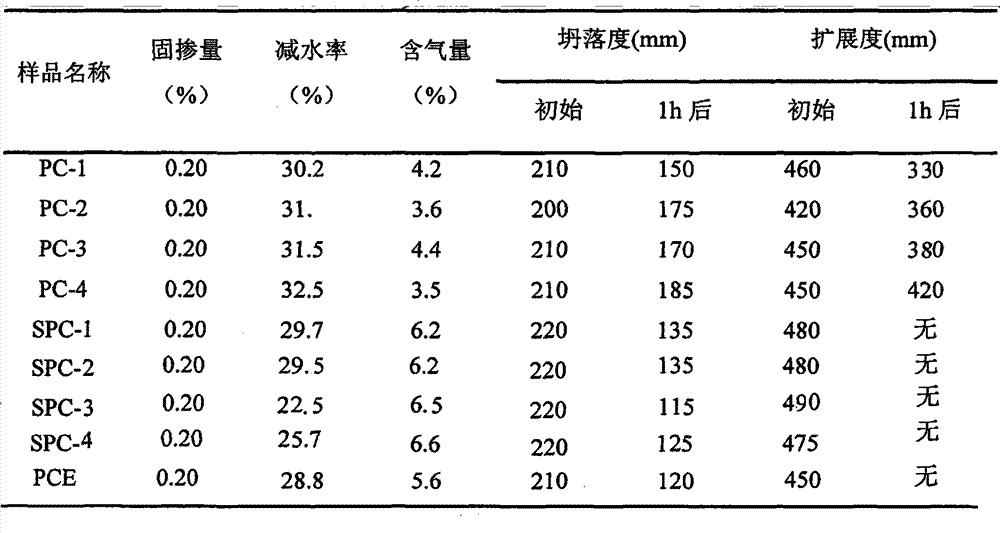Polycarboxylic acid water reducing agent
A technology of water reducing agent and polycarboxylic acid, applied in the field of polycarboxylic acid water reducing agent, can solve problems such as poor slump retention performance
- Summary
- Abstract
- Description
- Claims
- Application Information
AI Technical Summary
Problems solved by technology
Method used
Image
Examples
Embodiment 1
[0036] Add 25.0g of A-1, 60.0g of water, and 5.0g of 30% hydrogen peroxide into a 500ml four-necked flask equipped with a stirrer, a thermometer and a dropping device, and stir to raise the temperature to 65°C. At the same time, 21.6g vitamin C aqueous solution (obtained by dissolving 0.4g vitamin C, 1.2g 3-mercaptopropionic acid in 20.0g water) and 159.0g monomer aqueous solution (obtained by 50.0g B-1, 10.0g C-1, 21.0 gD-1 mixed with 78.0 g of water), the dropping time was controlled at 210 minutes and 180 minutes respectively, and the reaction temperature was controlled at 63-67°C. After the dropwise addition, keep the temperature at 63-67°C for 30 minutes to complete the polymerization reaction. After the heat preservation is completed, lower the temperature to below 50°C and add 44.4g of 30% NaOH aqueous solution to obtain the polycarboxylate superplasticizer PC-1 of the present invention, which has a solid content of 42.5% and a weight average molecular weight of 107,500...
Embodiment 2
[0038] Add 10.0 g of A-2, 50.0 g of water, and 5.0 g of 30% hydrogen peroxide into a 500 ml four-necked flask equipped with a stirrer, a thermometer, and a dropping device, and stir to raise the temperature to 65°C. At the same time, 22.1g vitamin C aqueous solution (obtained by dissolving 0.6g vitamin C, 1.5g 3-mercaptopropionic acid in 20.0g water) and 146.0g monomer aqueous solution (obtained by 65.0g B-1, 1.0g C-1, 30.0g D -1 dissolved in 50.0 g of water), the dropping time was controlled at 210 minutes and 180 minutes respectively, and the reaction temperature was controlled at 63-67°C. After the dropwise addition, keep the temperature at 63-67°C for 30 minutes to complete the polymerization reaction. After the heat preservation is completed, lower the temperature to below 50° C. and add 37.0 g of 30% NaOH aqueous solution to obtain the polycarboxylate superplasticizer PC-2 of the present invention, which has a solid content of 45.6% and a weight average molecular weight ...
Embodiment 3
[0040] Add 25.0 g of A-3, 50.0 g of water, and 5.0 g of 30% hydrogen peroxide into a 500 ml four-necked flask equipped with a stirrer, a thermometer, and a dropping device, and stir to raise the temperature to 65°C. At the same time, 22.1g of vitamin C aqueous solution (obtained by dissolving 0.6g of vitamin C and 1.5g of 2-mercaptopropionic acid in 20.0g of water) and 200.0g of monomer aqueous solution (from 50.0g of B-2 and 10.0g of C-2, 21.0 g D-2 was dissolved in 78.0 g of water), the dropping time was controlled at 180 minutes and 150 minutes respectively, and the reaction temperature was controlled at 63-67°C. After the dropwise addition, keep the temperature at 63-67°C for 30 minutes to complete the polymerization reaction. After the heat preservation is completed, lower the temperature to below 50°C and add 42.0 g of 30% sodium hydroxide aqueous solution to obtain the polycarboxylate water reducer PC-3 of the present invention, which has a solid content of 48.8% and a ...
PUM
 Login to View More
Login to View More Abstract
Description
Claims
Application Information
 Login to View More
Login to View More - R&D
- Intellectual Property
- Life Sciences
- Materials
- Tech Scout
- Unparalleled Data Quality
- Higher Quality Content
- 60% Fewer Hallucinations
Browse by: Latest US Patents, China's latest patents, Technical Efficacy Thesaurus, Application Domain, Technology Topic, Popular Technical Reports.
© 2025 PatSnap. All rights reserved.Legal|Privacy policy|Modern Slavery Act Transparency Statement|Sitemap|About US| Contact US: help@patsnap.com



